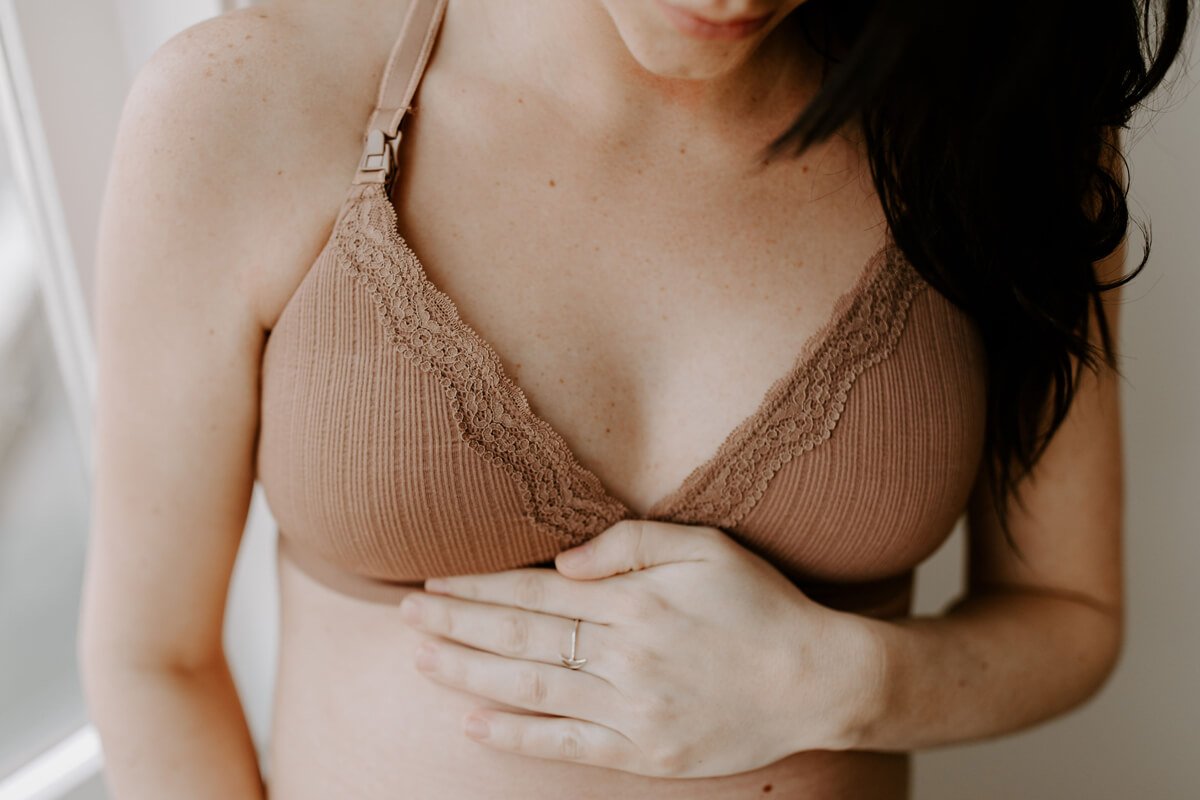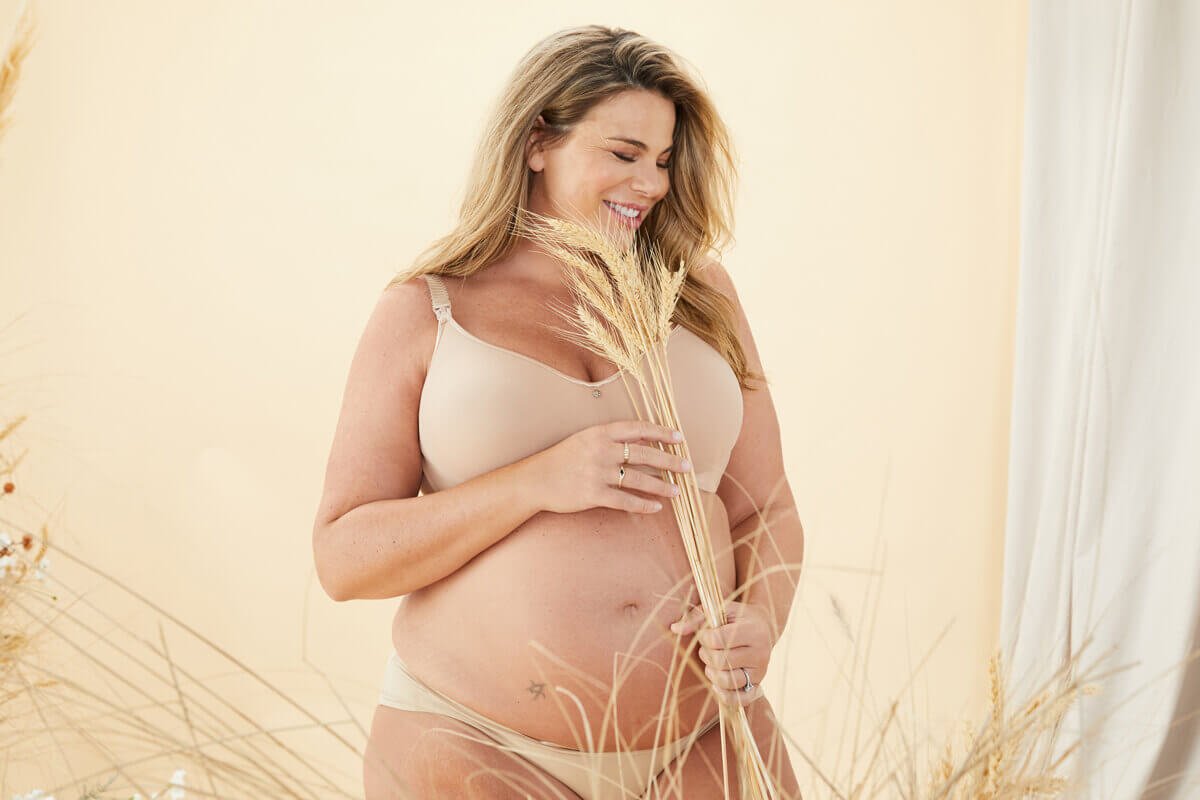Does Breast Size or Shape Affect Breastfeeding?
Katie, Head Designer at Cake Maternity
Did you know that breast size is not directly proportional to milk production? Despite what many believe, having bigger breasts does not necessarily mean you will produce more milk. In fact, the opposite can be true in some cases. It's a common misconception that can often lead to unnecessary stress and worry for new mothers. However, what matters is the glandular tissue, milk ducts, and alveoli that form after conception. So, regardless of your breast size, if you can become pregnant, you have the potential to feed your little one. In other words, size doesn't matter when it comes to nurturing your baby.
How breast size can impact breastfeeding?
Large breasts
Large breasts are perfectly capable of breastfeeding. However, there are some challenges that you may need to overcome. Some of these include:
The nipple and areola may be too large for your baby to get a good latch.
The rate of flow may also be a lot higher, and this can result in your baby not getting enough because they are choking. If this is the case, try nursing on your back with your baby leaning over you as this can slow the flow.
Too much breast tissue may encroach on the development of the milk ducts and inhibit glandular tissue growth.
Not being able to be comfortable in a nursing position.
Not being able to see your baby’s latch.
Small breasts
The size and shape of your breasts does not dictate the quality of the milk you will produce. If you have smaller breasts, you will still be able to produce the same amount of milk, or even more, than a larger busted mama. The amount of glandular tissue you produce through your pregnancy will determine your success, not the fatty tissue that determines your cup size.
Truffles Nursing Bra
Inverted or flat nipples
Although inverted nipples can make breastfeeding seem challenging, it is still possible to breastfeed successfully. While protruding nipples are ideal for breastfeeding, there are methods to convert inverted nipples. These methods include using suction cups or stimulating the nipples through massage and cool packs. After your baby learns how to feed, they may not require any pre-stimulation to latch properly.
Large nipples
When a baby's mouth is significantly smaller than a mother's nipple and areola, it can be challenging for them to latch correctly and receive adequate milk flow. To address this issue, a mother may consider using a breast pump and bottle feeding for the first few weeks until the baby grows a bit more. Alternatively, she can try reshaping her breast to help the baby get more of the nipple and areola into their mouth for a better latch.
Insufficient Glandular Tissue – IGT
Tutti Frutti Nursing Bra
If you are struggling to produce milk, you may have a rare condition known as Insufficient Glandular Tissue (IGT), which is not related to breast size. However, some women have reported better results during their second pregnancy as some glandular cells may have already developed.
It's important to note that the more you breastfeed, the more your glandular cells will develop, enabling you to produce more milk. So, even if you feel like you're not producing enough milk at the beginning, don't give up. Research shows that milk production and glandular tissue typically increase after about 12 weeks of consistent breastfeeding. However, your breasts are less likely to become engorged during this time, and milk production will be in direct response to your baby's needs.
Nursing bras for petite busts
Being smaller busted doesn’t mean you don’t need support and comfort. We’ve heard so many fuller busted mamas say they wish they didn’t have larger boobs so they don’t have to wear a bra. A nursing breast will still be heavier, more sensitive, and possibly even leaking, no matter what the size!
At Cake Maternity, your support, comfort and ease of access is our top priority no matter what size you are. Whether you want flexi-wire, seamless, a sports bra or a sexy lacy number – we’ve got something for you.
Nursing bras for fuller busts
Taffy Nursing Bra
If you already have a fuller bust before getting pregnant, you may be concerned about finding the right support during your breastfeeding journey. Did you know that a lactating bust can be up to 33% heavier than a non-lactating one? That's why all of our bras, designed specifically for the fuller bust, take this into consideration.
We understand that you needed support and comfort even before becoming pregnant, but now, it's even more crucial. It's your right to feel comfortable and adequately supported throughout this process, not just for your own well-being but also for your baby's. We've done everything we can to ensure that our nursing bras provide the support and comfort you need to breastfeed for as long as possible, because a happy baby means a happy mama and a happy earth/future/universe, and so on.
Our larger cupped bras come with double and triple layers, reinforced straps, wider elastics, more hooks and eyes, stronger wires with greater flexibility, and superior fabrics and yarns that will last the distance. We're confident that you'll find the perfect fit and support you need, so you can focus on enjoying this special time with your little one.
Croissant Nursing Bra
Why do I have more milk in one breast than the other?
It's common for one eyebrow to sit higher than the other, or for one foot to be slightly longer or wider than the other. And just like these natural differences, you may have noticed that one breast sits higher than the other or that your bra feels firmer in one cup - even before becoming pregnant. This is because our bodies are naturally asymmetrical.
During breastfeeding, it's also common for one breast to develop more milk ducts, causing it to refill at a higher rate than the other breast. Your baby may also prefer one breast over the other, whether it's due to their preferred feeding position, the different flow between breasts, or simply because they like to look out the window instead of the door.
However, this preference can cause an imbalance in the supply and demand of milk, resulting in different levels of fullness in each breast. Don't worry though - this is normal, and your body will adjust to meet your baby's needs. It's important to offer both breasts during feeding sessions and to alternate which breast you start with to ensure that both breasts are stimulated and producing milk. With time, your milk supply will regulate, and your breasts will likely even out in terms of fullness.
Will breastfeeding change how my breasts look?
It's common for breastfeeding to cause changes in how your breasts look. Your body has gone through a lot of changes during pregnancy and childbirth, and these changes may not completely revert back to their pre-pregnancy state. However, it's important to note that these changes are often due to weight gain and loss, rather than breastfeeding itself.
Some factors that can further change the appearance of your breasts include:
Not enough support when at their fullest.
Not enough support immediately after a feed.
Wearing a bra that is too small. Unwanted overall pressure can affect your breastfeeding function, as can firm elastics or incorrect-sized wires.
Wearing a bra that is too big. For this reason, it’s important to be correctly fitted each time your size changes when breastfeeding or pregnant.
Weaning cold turkey or over a short period of time.
Not breastfeeding at all when your milk comes in. When breastfeeding, your body naturally adjusts collagen, tissues, and ligaments accordingly to the additional weight and changes in your breasts. If you don’t breastfeed after you’re first engorged, your body doesn’t have time to counteract the process.
Breastfeeding is a natural process that can be achieved by most women who are able to conceive. It's important to remember that the ability to breastfeed is not determined by breast size, but rather by a complex interplay of hormones, physical and emotional factors
Perseverance is crucial when it comes to breastfeeding. Some days may be more challenging than others, but with patience and persistence, most mothers can successfully breastfeed their babies. Remember to seek support from your healthcare provider or a lactation consultant if you encounter any difficulties.
Breastfeeding is a rewarding experience that can provide numerous benefits for both you and your baby. By choosing to breastfeed, you are providing your baby with the best possible nutrition and nurturing a special bond between the two of you. So, stay positive, keep going, and enjoy the journey!
Katie is the proud mum of two beautiful girls and has been responsible for all the designs, style, and fit at Cake Maternity for over a decade.
Katie is a nursing bra specialist and a fit, pattern, and grading technician. She is passionate about breastfeeding and the many benefits it offers to both mom, baby, and the environment.
She is determined to make the breastfeeding journey a comfortable, supportive, and beautiful one for all moms, understanding that it doesn’t always come easy to everyone. That’s why she has made it her mission to empower women as they mindfully navigate the world of motherhood and help make breastfeeding easier through experience-driven innovation.







